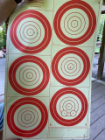"Ladder test" means different things these days.
The original ladder test as described by Creighton Audette was to shoot one shot each of incremental increases of powder charge to the same point of aim, and see if there is a point where the shots tend to clump together.
Because that ladder test was so spectacularly useless for me, I tried to figure out why, and the best I can come up with is that the point where the shots on paper clump together is where the barrel harmonics reverse. When velocity is tracked as well, consecutive velocities may be closer together due to a +- 1 thou [ very small ] variation in seating depth between consecutive rounds. If one round is -1 thou, and the next +1 thou, those velocities will tend to be closer together because the increase in length reduces the effect of the increase in charge. The points where the shots are closer on paper, and where the velocity is closer together do not always overlap. The test clearly shows that you can change barrel harmonics with incremental change to powder charge. You can find a good load eventually this way, with a chance of shooting out the barrel before you do.
I find it more productive and less of a waste of components to find a low ES first, then manipulate group size with seating depth change. Both these tests can loosely be called ladder tests, but I prefer to avoid using the term altogether.











